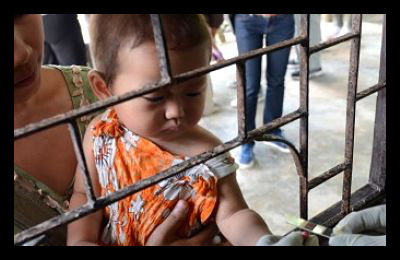Vaccines Seek to “Spread What Works”

When the eight Millennium Development Goals were created in 2000, one of the goals to be reached by 2015 became to reduce the mortality rate in children under five by two-thirds.
While the ambitious goal of a two-thirds reduction has not been met, the United Nation’s Children’s fund has recently reported that in the past thirteen years, death rates in children under five have been cut in half.
Studies show various ways death in children have been reduced by more women giving birth in hospitals or with skilled and educated health workers. Improvements have also been seen with increased awareness of the importance of skin-on-skin contact with a newborn and mother, breastfeeding, family planning and immunizations.
Immunizations are simple and effective ways to prevent diseases that take lives of many children a year.
While immunizations are effective in saving lives, the report showed more than six million children die per year from preventable causes. That’s almost 17,000 children dying every day from the inability to receive a vaccine that would prohibit a disease from taking their lives.
Among common life-threatening diseases are pneumonia, malaria, diarrhea and measles. All these diseases can be prevented with a vaccine. UNICEF’s head of global programs, Dr. Mickey Chopra, said, “The challenge is to spread what works. It is very, very easy to prevent … diseases from killing kids. An antibiotic is 10, 20 cents, and that saves the life basically.”
While these vaccines cost very little, vaccine packages that treat about a dozen diseases have increased in price by almost 2700 percent between the years of 2001 and 2011. In the latter year, the UNICEF Supply Division performed a study and found that “Western companies often charged UNICEF twice as much for its medication than Indian and Indonesian companies.” It is noted however, that as competition arose in the pharmaceutical market, prices have not shifted.
Though prices are high and funding for vaccinations that would prevent death in millions of children seems at times like a lost cause, there is hope in sight. In June of this year, the GAVI Alliance Board announced plans to immunize 300 million children between 2016 and 2020, hoping to save between an estimated five to six million lives in just four years.
The GAVI press release stated it is projected nearly 50 percent children in 73 GAVI- supported countries will receive all 11 immunizations recommended by the World Health Organization by 2020- a more than 45 percent increase than is seen today.
Chair of the GAVI Alliance, Daginn Hoybraten, said of the Alliance has the opportunity, “to build and strengthen immunization programs that will benefit the children of today as well as generations to come.”
– Kori Withers
Sources: GAVI Alliance, Think Progress, Huffington Post World Health Organization
